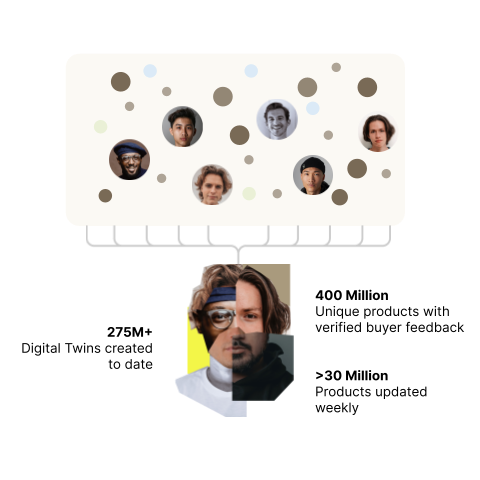Competitive Analysis for the CPG Industry
AI-powered customer feedback so you can take action now
Native AI turns insight into impact
Introducing Native AI, the always-on market intelligence platform that helps you understand, innovate, and create ideal experiences for your customers.

A better way to find the answers you need
Create impact through measurable improvements to products, customer experience, and marketing.
-
Analyze millions of qualitative and quantitative data points
-
Automate product and keyword tracking across the web
- Converse with digital clones of your customers in real-time
Insights Dashboard
Customize and export reports with full choice of visualizations. Set up alerts for specific products and keywords, and monitor trends over time in order to predict future consumer behaviors and identify white-space opportunities.


Bring Your Own Data
Upload your first party data in any structured or unstructured format. Our platform is compliant with international data processing regulations to eliminate unnecessary risk.
Digital Twins
Converse with digital clones of your customers or your competitors' customers. Filter by demographic, purchase channel, behavior, and more. Create visualizations and export your results.

Expert White-Glove Service
Our platform is designed for you to be successful independently, but we're here to make sure you’re able to take full advantage of the value Native AI provides.
The Native AI Difference
We're not like other all-in-one insights platforms. Get a peek under the hood.
Data Safety & Privacy
Advanced Orchestration
Synthetic Output Controls
Competitive Analysis for the CPG Industry
The consumer packaged goods (CPG) industry is known for being highly competitive, fast-paced, and dynamic. It covers a large swath of sub-industries, such as beverage, cosmetics, and household goods. A thorough competitive analysis for the CPG industry involves an in-depth examination of companies in the same market space, allowing us to compare products, marketing strategies, and performance. The ultimate goal is to identify strengths and weaknesses relative to competitors and understand consumer sentiment.
One effective competitive analysis model is the SWOT model, an acronym for strengths, weaknesses, opportunities, and threats. The purpose of SWOT analysis is to recognize the internal and external factors influencing the success or failure of a product or business. Strengths and weaknesses are internal characteristics of a company, such as an innovative product or a weak distribution channel. In contrast, opportunities and threats often emerge from external conditions like changing consumer tastes or a new market entrant. By executing a comprehensive SWOT analysis, CPG companies can assess their competitive positioning and devise strategies to capitalize on opportunities and mitigate threats.
Another major factor is competitive pricing. This strategy involves setting the price of a product or service based on what the competition is charging. For instance, if a soft drink company knows its competitor is selling a cola drink for $1.50, it may choose to price its cola at $1.40 to attract consumers looking for a better value. However, competitive pricing is a delicate balance and must consider profit margins and cost structures. Brand equity carries some weight; consumers may be likely to pick a product with a slightly higher price point if the brand elicits trust.
Lastly, it is paramount to discuss the meaning of a term frequently used in strategic analysis: competitive advantage. The definition of competitive advantage is a unique trait or ability that allows a company to outperform its competitors. This can be anything from superior technology, a patent, brand reputation, to economies of scale. A well-conducted competitive analysis often helps identify ways to achieve and sustain a competitive advantage.
Through tools like SWOT analysis, practices such as competitive pricing, and the pursuit of unique competitive advantages, businesses in the CPG industry can engage in astute competitive analysis, skillfully navigate the market's waves, and optimally position themselves for success.
Competitive Analysis Examples
Competitive analysis shapes the foundation of any robust business strategy, therefore we can pull examples from any industry. To demonstrate how these look, here are three non-CPG examples that we will explore: Tesla SWOT analysis, McDonald's SWOT analysis, and Starbucks SWOT analysis.
Tesla, a spearhead in the electric vehicle market, has strengths such as being early to market, cutting-edge technology, and sustainable energy focus. While the high cost of products and limited scale of production poses a weakness, the opportunities lie in rising global awareness towards sustainable vehicles and the unexplored potential in various international markets. The threat, however, is stiff competition in the electric automotive industry and regulatory obstacles in diverse regions.
McDonald's SWOT analysis offers another compelling case study in the realm of competitive analysis examples. Strengths such as brand recognition and global reach, along with a vast customer base, drive the business. The weaknesses revolve around public perception about health and quality, whereas the opportunities lie in the increasing demand for healthier food options and potential market expansion. Threats include new entrants and existing competition in the fast food industry.
Lastly, the Starbucks SWOT analysis presents a curious competitive landscape. Starbucks boasts a robust global presence and premium branding among its strengths. However, the high pricing strategy and the dependence on the American market form the weaknesses. The booming coffee culture across the globe and potential for menu diversification presents opportunities. Yet, the brand faces threats from local cafes and the volatile price of coffee beans.
Each of these competitive analysis examples provides valuable insights into their respective industries and unravels distinctive strategies for maintaining competitive advantages.
Marketing Analysis
Marketing analysis serves as the cornerstone for any successful business venture. As mentioned above, brand recognition can play a large factor in consumer perception, and can even lead people to pay more for a product if they have positive associations with that brand. A comprehensive understanding of your brand value provides insightful directions, fostering data-driven decision-making that ultimately shapes your organization's growth trajectory.
Let’s start with competitive positioning. Competitive positioning distinguishes your brand in today's overcrowded marketplace. Tailoring unique selling propositions that resonate with target demographics enhances your brand's appeal, heightening its visibility and expanding its reach. However, this is achievable only if your brand's positioning seamlessly aligns with your target consumer's perspective.
Now let’s look at competitive pricing again through the lens of marketing value. Pricing your products lower than competitors may have some advantages, but it’s important to not overlook the negative, such as perception of “cheapness.” A well-known brand can command a higher price point, and consumers often believe this is justified as the better-known brand is “higher quality.” Therefore, it’s important that you do not simply price your products lower than competitors in all cases. This is how you achieve premium status within a niche market segment.
Lastly, we discuss brand analysis and health monitoring, a comprehensive exercise that assesses and interprets your brand's current standing amongst consumers. Remember: branding is all about perception. What people think about your brand is more important than what you say it is. Through constant monitoring and evaluation, brand analysis maintains your brand's health, keeping it relevant and competitive in the ever-dynamic market landscape. This analysis comprises auditing customer perceptions, gauging brand differentiation, and evaluating the brand's value proposition.
Overall, a keen understanding of these intrinsic elements facilitates the creation of well-rounded marketing strategies, bolstering your brand's position and fostering sustained growth in today's competitive market.
Value Chain Analysis
Undeniably, one of the most-overlooked aspects of competitive analysis is the overall value chain analysis – an integral process that highlights each step from product conception, down to the consumer, thereby aligning the business with its key competencies. It dissects the company's primary and supportive activities, bestowing an extensive understanding of its operational, cost, and efficiency structures. However, it should not pose as a standalone business strategy.
Large established businesses, for example, will likely have lower costs at scale than smaller businesses who lack negotiating power. This means that a larger brand’s value chain standing is superior to smaller businesses. Small companies need to make up for this in other ways, such as excellent service, better brand perception, and other brand factors.
Businesses operate in dynamic environments, and this is called the 'industry life cycle'. This vital component pertains to the progression of an industry over time. It is manifested in four stages – introduction, growth, maturity, and decline. Each phase presents both unique opportunities and myriad hurdles. Mastering the nuances of this cycle allows businesses to forecast trends, adopt innovative strategies, and ultimately broaden their competitive advantage.
Thus, integrating the concept of the value chain analysis, industry life cycle, and SWOT analysis provides an extensive, reliable method for identifying business strategies that align with the overarching corporate vision and targets. It’s key to continue monitoring these metrics over time, as the dynamic environment is ever-changing as are consumer perceptions and trends.
To learn more about how Native AI can help you stay on top of consumer trends and competitive monitoring, visit our solutions page.
